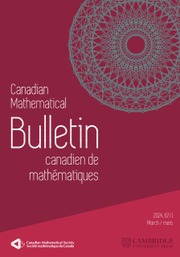Article contents
The Minimal Number of Three-Term Arithmetic Progressions Modulo a Prime Converges to a Limit
Published online by Cambridge University Press: 20 November 2018
Abstract
How few three-term arithmetic progressions can a subset  $S\,\subseteq \,{{\mathbb{Z}}_{N}}\,:=\,\mathbb{Z}\,/\,N\mathbb{Z}$ have if
$S\,\subseteq \,{{\mathbb{Z}}_{N}}\,:=\,\mathbb{Z}\,/\,N\mathbb{Z}$ have if  $|S|\,\ge \,\upsilon N$ (that is,
$|S|\,\ge \,\upsilon N$ (that is,  $S$ has density at least
$S$ has density at least  $\upsilon$ )? Varnavides showed that this number of arithmetic progressions is at least
$\upsilon$ )? Varnavides showed that this number of arithmetic progressions is at least  $c(v)\,{{N}^{2}}$ for sufficiently large integers
$c(v)\,{{N}^{2}}$ for sufficiently large integers  $N$ . It is well known that determining good lower bounds for
$N$ . It is well known that determining good lower bounds for  $c\left( \upsilon\right)\,>\,0$ is at the same level of depth as Erdös's famous conjecture about whether a subset
$c\left( \upsilon\right)\,>\,0$ is at the same level of depth as Erdös's famous conjecture about whether a subset  $T$ of the naturals where
$T$ of the naturals where  $\sum{_{n\in T}\,1/n}$ diverges, has a
$\sum{_{n\in T}\,1/n}$ diverges, has a  $k$ -term arithmetic progression for
$k$ -term arithmetic progression for  $k\,=\,3$ (that is, a three-term arithmetic progression).
$k\,=\,3$ (that is, a three-term arithmetic progression).
We answer a question posed by B. Green about how this minimial number of progressions oscillates for a fixed density  $\upsilon$ as
$\upsilon$ as  $N$ runs through the primes, and as
$N$ runs through the primes, and as  $N$ runs through the odd positive integers.
$N$ runs through the odd positive integers.
Keywords
Information
- Type
- Research Article
- Information
- Copyright
- Copyright © Canadian Mathematical Society 2008
References
- 7
- Cited by

